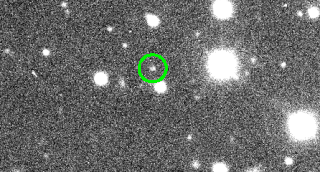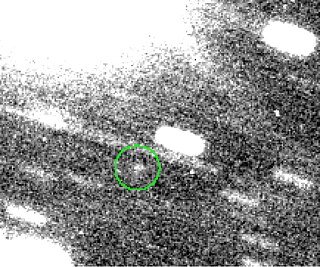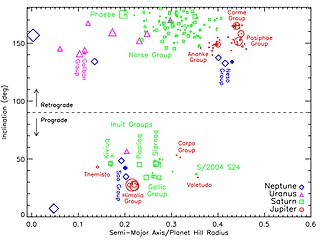
Carme is a retrograde irregular satellite of Jupiter. It was discovered by Seth Barnes Nicholson at Mount Wilson Observatory in California in July 1938. It is named after the mythological Carme, mother by Zeus of Britomartis, a Cretan goddess.

Lysithea is a prograde irregular satellite of Jupiter. It was discovered by Seth Barnes Nicholson in 1938 at Mount Wilson Observatory and is named after the mythological Lysithea, daughter of Oceanus and one of Zeus' lovers.

Leda, also known as Jupiter XIII, is a prograde irregular satellite of Jupiter. It was discovered by Charles T. Kowal at the Mount Palomar Observatory on September 14, 1974, after three nights' worth of photographic plates had been taken. It was named after Leda, who was raped by Zeus, the Greek equivalent of Jupiter. Kowal suggested the name and the IAU endorsed it in 1975.

Ananke is a retrograde irregular moon of Jupiter. It was discovered by Seth Barnes Nicholson at Mount Wilson Observatory in 1951 and is named after the Greek mythological Ananke, the personification of necessity, and the mother of the Moirai (Fates) by Zeus. The adjectival form of the name is Anankean.

Pasiphae, formerly spelled Pasiphaë, is a retrograde irregular satellite of Jupiter. It was discovered in 1908 by Philibert Jacques Melotte and later named after the mythological Pasiphaë, wife of Minos and mother of the Minotaur from Greek legend.

Sinope is a retrograde irregular satellite of Jupiter discovered by Seth Barnes Nicholson at Lick Observatory in 1914, and is named after Sinope of Greek mythology.

Themisto, also known as Jupiter XVIII, is a small prograde irregular satellite of Jupiter. It was discovered in 1975, subsequently lost, and rediscovered in 2000.

Kale, also known as Jupiter XXXVII, is a retrograde irregular satellite of Jupiter. It was discovered in 2001 by astronomers Scott S. Sheppard, D. Jewitt, and J. Kleyna, and was originally designated as S/2001 J 8.

There are 95 moons of Jupiter with confirmed orbits as of 23 October 2023. This number does not include a number of meter-sized moonlets thought to be shed from the inner moons, nor hundreds of possible kilometer-sized outer irregular moons that were only briefly captured by telescopes. All together, Jupiter's moons form a satellite system called the Jovian system. The most massive of the moons are the four Galilean moons: Io, Europa, Ganymede, and Callisto, which were independently discovered in 1610 by Galileo Galilei and Simon Marius and were the first objects found to orbit a body that was neither Earth nor the Sun. Much more recently, beginning in 1892, dozens of far smaller Jovian moons have been detected and have received the names of lovers or daughters of the Roman god Jupiter or his Greek equivalent Zeus. The Galilean moons are by far the largest and most massive objects to orbit Jupiter, with the remaining 91 known moons and the rings together composing just 0.003% of the total orbiting mass.

Harpalyke, also known as Jupiter XXII, is a retrograde irregular satellite of Jupiter. It was discovered by a team of astronomers from the University of Hawaii led by Scott S. Sheppard in 2000, and given the temporary designation S/2000 J 5. In August 2003, the moon was named after Harpalyke, the incestuous daughter of Clymenus, who in some accounts was also a lover of Zeus (Jupiter).

Hermippe, or Jupiter XXX, is a natural satellite of Jupiter. It was discovered concurrently with Eurydome by a team of astronomers from the Institute for Astronomy of the University of Hawaii led by David Jewitt and Scott S. Sheppard and Jan Kleyna in 2001, and given the temporary designation S/2001 J 3.

Praxidike, also known as Jupiter XXVII, is a retrograde irregular satellite of Jupiter. It was discovered by a team of astronomers from the University of Hawaii led by Scott S. Sheppard in 2000, and given the temporary designation S/2000 J 7.

Chaldene, also known as Jupiter XXI, is a retrograde irregular satellite of Jupiter. It was discovered by a team of astronomers from the University of Hawaii led by Scott S. Sheppard, in 2000, and given the temporary designation S/2000 J 10.

Isonoe, also known as Jupiter XXVI, is a retrograde irregular satellite of Jupiter. It was discovered by a team of astronomers from the University of Hawaii led by Scott S. Sheppard in 2000, and given the temporary designation S/2000 J 6.
Dia, also known as Jupiter LIII, is a prograde irregular satellite of Jupiter. Provisionally known as S/2000 J 11, it received its name on March 7, 2015. It is named after Dia, daughter of Deioneus, wife of Ixion. According to Homer, she was seduced by Zeus in stallion form; Pirithous was the issue.

Ferdinand is the outermost retrograde irregular satellite of Uranus. It was first seen near Uranus by Matthew J. Holman, John J. Kavelaars, Dan Milisavljevic, and Brett J. Gladman on August 13, 2001 and reobserved on September 21, 2001. The object was then lost with no confirmation it was actually orbiting around Uranus.

The Ananke group is a group of retrograde irregular satellites of Jupiter that follow similar orbits to Ananke and are thought to have a common origin.

The Carme group is a group of retrograde irregular satellites of Jupiter that follow similar orbits to Carme and are thought to have a common origin.

The Pasiphae group is a group of retrograde irregular satellites of Jupiter that follow similar orbits to Pasiphae and are thought to have a common origin.

In astronomy, an irregular moon, irregular satellite or irregular natural satellite is a natural satellite following a distant, inclined, and often eccentric and retrograde orbit. They have been captured by their parent planet, unlike regular satellites, which formed in orbit around them. Irregular moons have a stable orbit, unlike temporary satellites which often have similarly irregular orbits but will eventually depart. The term does not refer to shape; Triton for example, is a round moon, but is considered irregular due to its orbit.

















